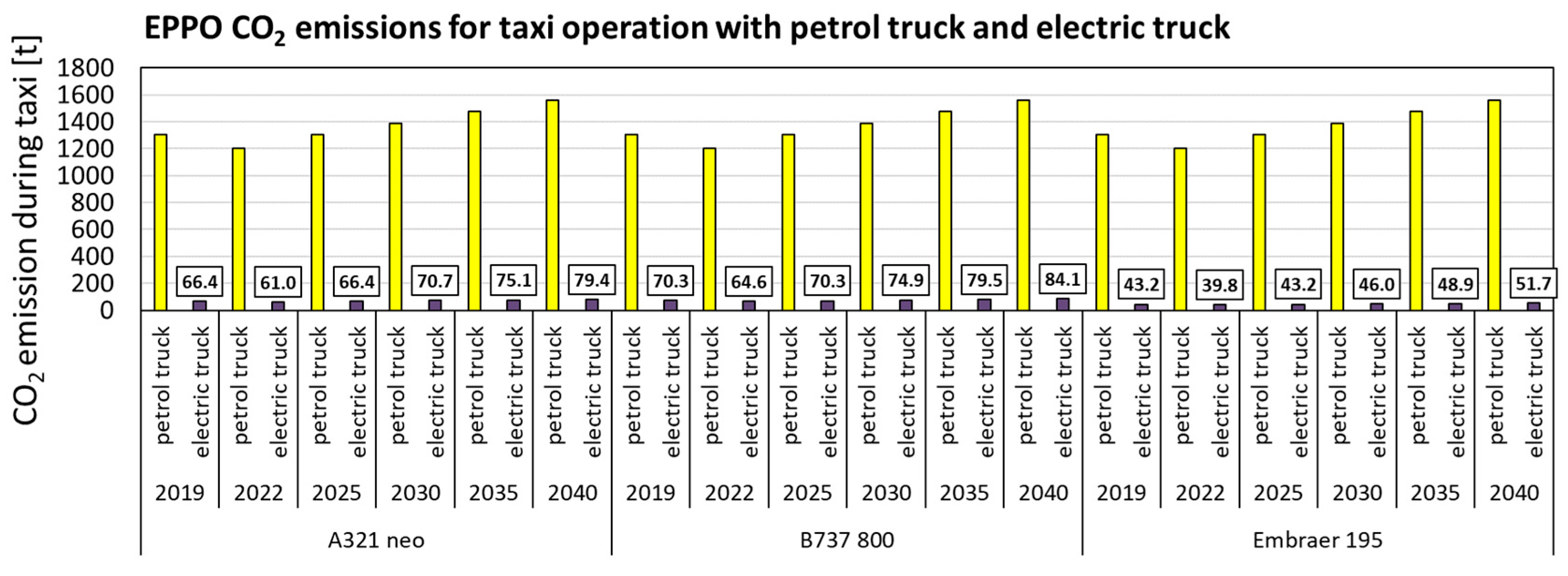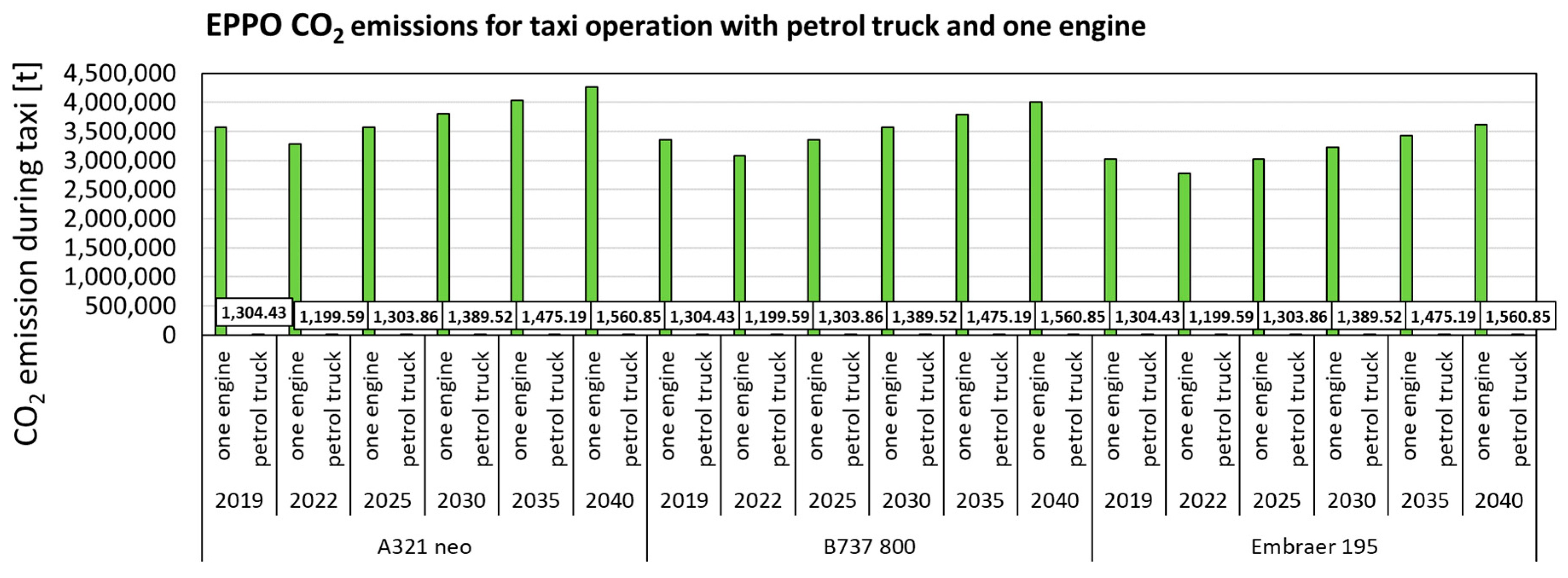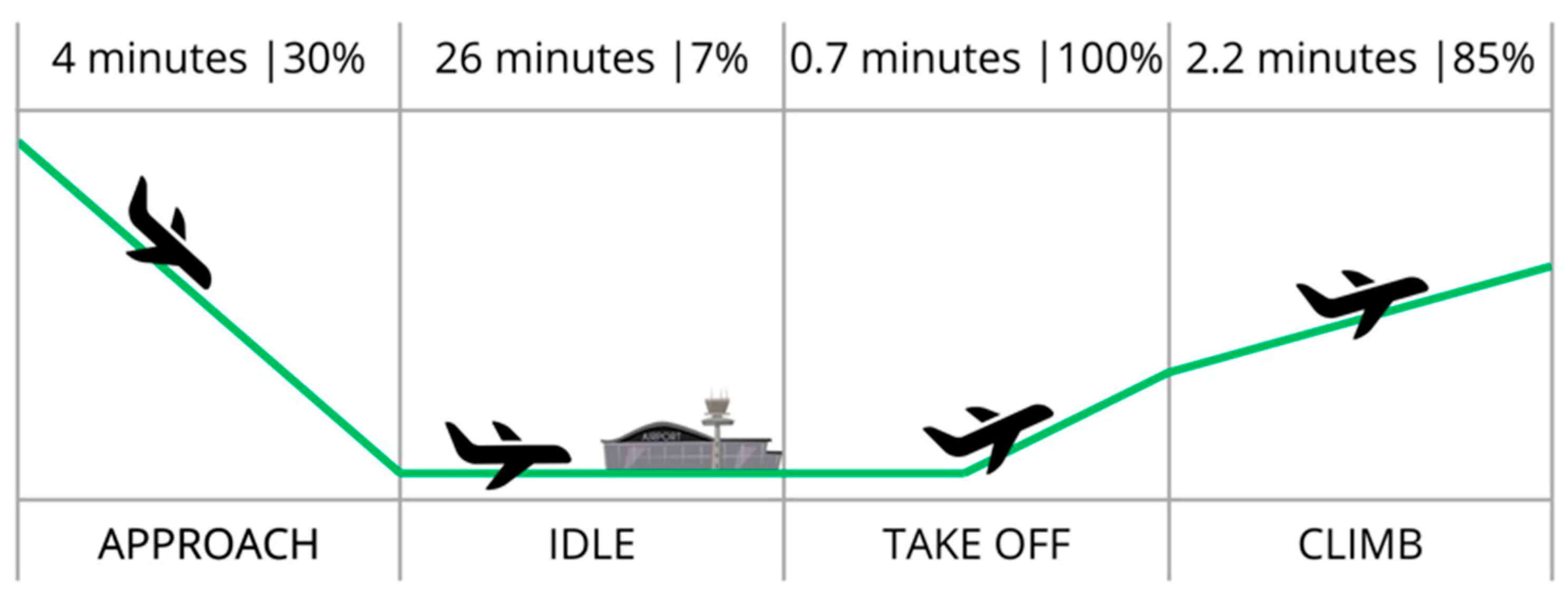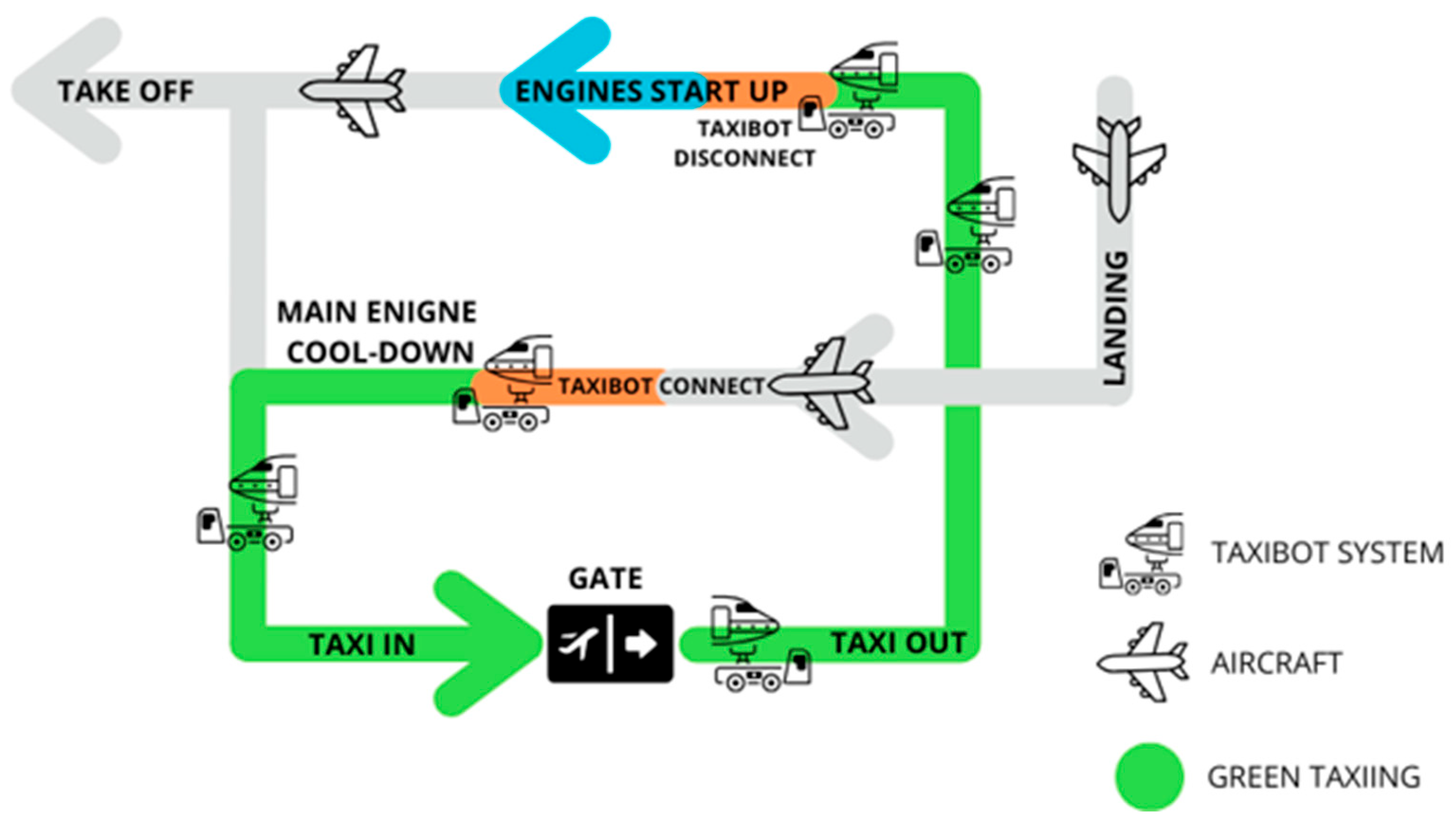Towards Sustainable Airport Operations: Emission Analysis of Taxiing Solutions
Abstract
1. Introduction
2. Methods
2.1. Full-Engine and Half-Engine Emissions
- EPCpol, mode—emissions per cycle of specified pollutant in selected LTO mode [g/cycle]; TIM—time in mode [min/cycle], with 60 min per hour [min/h]; FFR—fuel flow rate [kg/h]; EF—emission factor [g/kg]; and NE—number of engines on the aircraft.
2.2. Electric Towing Vehicle Emissions
2.3. Diesel- and Petrol-Fueled Towing Vehicle
2.4. Emission Forecast for EPPO and EPWA Airports
3. Results and Discussion
3.1. Emissions of One-Minute Towing
3.2. Emissions of Harmful Exhaust Compounds for EPWA and EPPO
3.3. EPPO NOx and CO2 Emission Forecast



3.4. EPWA NOx and CO2 Emission Forecast



4. Discussion
5. Conclusions
Author Contributions
Funding
Institutional Review Board Statement
Informed Consent Statement
Data Availability Statement
Conflicts of Interest
References
- Masiol, M.; Harrison, R.M. Aircraft engine exhaust emissions and other airport-related contributions to ambient air pollution: A review. Atmos. Environ. 2014, 95, 409–455. [Google Scholar] [CrossRef] [PubMed]
- International Civil Aviation Organization (ICAO). Airport Air Quality Manual; Doc. 9889; ICAO: Montreal, QC, Canada, 2020. [Google Scholar]
- Webb, S.; Whitefield, P.D.; Miake-Lye, R.C.; Timko, M.T.; Thrasher, T.G. Research Needs Associated with Particulate Emissions at Airports; ACRP Report 6; Transportation Research Board: Washington, DC, USA, 2008. [Google Scholar]
- Mazaheri, M.; Johnson, G.R.; Morawska, L. An inventory of particle and gaseous emissions from large aircraft thrust engine operations at an airport. Atmos. Environ. 2011, 45, 3500–3507. [Google Scholar] [CrossRef]
- Galant-Gołębiewska, M.; Jasiński, R.; Nowak, M.; Kurzawska, P.; Maciejewska, M.; Ginter, M. Methodical aspects of the LTO cycle use for environmental impact assessment of air operations based on the Warsaw Chopin Airport. Aviation 2021, 25, 86–91. [Google Scholar] [CrossRef]
- Nowak, M.; Jasiński, R.; Frąckowiak, A. Adaptation of the LTO test to the local airports infrastructure. Transp. Res. Procedia 2020, 51, 349–356. [Google Scholar] [CrossRef]
- Maurizio, C.; Prapti, M.; Mauro, S.; Theo, H. Meta-analysis of life cycle assessments for Li-Ion batteries production emissions. arXiv 2018. [Google Scholar] [CrossRef]
- Xiu, W.; Wang, S.; Qi, W.; Li, X.; Wang, C. Charging strategies for electric ground support equipment in airports: A simulation-based analysis. Sustainability 2021, 13, 5032. [Google Scholar] [CrossRef]
- Ahmadi, S. Green Airport Operations: Conflict and Collision Free Taxiing Using Electric Powered Towing Alternatives. Ph.D. Thesis, Concordia University, Montréal, QC, Canada, 2019. [Google Scholar]
- Zoutendijk, M.; Mitici, M. Fleet scheduling for electric towing of aircraft under limited airport energy capacity. Energy 2024, 294, 130924. [Google Scholar] [CrossRef]
- van Baaren, E.; Roling, P.C. Design of a zero emission aircraft towing system. In AIAA Aviation 2019 Forum; AIAA: Reston, VA, USA, 2019. [Google Scholar] [CrossRef]
- Taxibot-International. Taxibot International. Available online: http://www.taxibot-international.com (accessed on 3 March 2024).
- International Civil Aviation Organization (ICAO). ICAO Aircraft Engine Emissions Databank; ICAO: Montreal, QC, Canada, 2023. [Google Scholar]
- European Union Aviation Safety Agency (EASA), ICAO Aircraft Engine Emissions Databank. Available online: https://www.easa.europa.eu/en/domains/environment/icao-aircraft-engine-emissions-databank (accessed on 14 April 2024).
- Hospodka, J.; Stloukal, B. Environmental impacts of using electric tow trucks. Transp. Res. Procedia 2023, 75, 161–172. [Google Scholar] [CrossRef]
- KOBiZE. CO2, SO2, NOx, CO and Total Dust Emission Indicators for Electricity Based on Information Contained in the National Database on Emissions of Greenhouse Gases and Other Substances for 2022; National Center for Emission Balancing and Management: Warsaw, Poland, 2023. [Google Scholar]
- Cao, F.; Tang, T.-Q.; Gao, Y.; You, F.; Zhang, J. Calculation and analysis of new taxiing methods on aircraft fuel consumption and pollutant emissions. Energy 2023, 277, 127618. [Google Scholar] [CrossRef]
- Halil, Y.; Akdeniz. Estimation of aircraft turbofan engine exhaust emissions with environmental and economic aspects at a small-scale airport. Aircraft Eng. Aerosp. Technol. 2022, 94, 176–186. [Google Scholar] [CrossRef]
- Yang, X.; Chen, S.; Lang, J.; Xu, R.; Lv, Z. Characterization of aircraft emissions and air quality impacts of an international airport. J. Environ. Sci.–China 2018, 72, 198–207. [Google Scholar] [CrossRef] [PubMed]
- Seyed, A.T.; Shafabakhsh, G.; Aghayan, I. Evaluation of aircraft emission at Imam Khomeini International Airport and Mehrabad International Airport. Int. J. Environ. Sci. Technol. 2019, 16, 6587–6598. [Google Scholar] [CrossRef]
- Di Paola, M.V.; Corazza, N.R.; Rosa, L.M. Optimization of Aircraft Taxiing Strategies to Reduce the Impacts of Landing and Take-Off Cycle at Airports. Sustainability 2022, 14, 9692. [Google Scholar] [CrossRef]
- Totakura, B.R.; Khanka, S.; Jagadeesan, A.K.; Khanna, A. Study of Carbon Emission During Taxi-Out Operation at International Airport. In Advances in Environment Engineering and Management; Springer: Cham, Switzerland, 2021; pp. 323–340. [Google Scholar] [CrossRef]
- International Council on Clean Transportation (ICCT). Effects of Battery Manufacturing on Electric Vehicle Life-Cycle Greenhouse Gas Emissions. 2018. Available online: https://theicct.org/wp-content/uploads/2021/06/EV-life-cycle-GHG_ICCT-Briefing_09022018_vF.pdf (accessed on 5 August 2025).
- Benidis, K.; Rangapuram, S.S.; Flunkert, V.; Wang, Y.; Maddix, D.; Turkmen, C.; Gasthaus, J.; Bohlke-Schneider, M.; Salinas, D.; Stella, L. Deep learning for time series forecasting: Tutorial and literature survey. arXiv 2020. [Google Scholar] [CrossRef]
- Masini, R.; Medeiros, M.C.; Mendes, E.F. Machine learning advances for time series forecasting. J. Econ. Surv. 2021, 35, 2070–2109. [Google Scholar] [CrossRef]
- Wang, Q.; Liu, Q.; Ma, Z.; Wang, J.; Ni, Y.; Ren, W.; Wang, H. Data interpretation and forecasting of SHM heteroscedastic measurements under typhoon conditions enabled by an enhanced Hierarchical sparse Bayesian Learning model with high robustness. Measurement 2024, 230, 114509. [Google Scholar] [CrossRef]
- Spiliotis, E. Time series forecasting with statistical, machine learning, and deep learning methods: Past, present, and future. In Forecasting with Artificial Intelligence; Springer: Cham, Switzerland, 2023; Available online: https://www.researchgate.net/publication/374080047 (accessed on 5 August 2025).





| Aircraft Type | Engine Model | Number of Engines | EI CO [g/kg] | EI HC [g/kg] | EI NOx [g/kg] | EI CO2 [kg/kg] | EI PM [kg/kg] |
|---|---|---|---|---|---|---|---|
| A321neo | PW1133G-JM | 2 | 17.89 | 0.05 | 6.98 | 3.16 | 0.001 |
| B737 8200 | LEAP-1B25 | 2 | 16.01 | 0.74 | 4.94 | 3.16 | 0.001 |
| Embraer 195 | GE CF34-10E5 | 2 | 49.98 | 6.39 | 3.51 | 3.16 | 0.001 |
| Aircraft Type | MTOW | Required Energy in kWh for 100% MTOW | Required Energy in kWh for 80% MTOW |
|---|---|---|---|
| A321neo | 78,000 | 0.638 | 0.510 |
| B737 8200 | 82,600 | 0.675 | 0.540 |
| Embraer 195 | 50,790 | 0.415 | 0.332 |
| Fuel Type | Fuel Consumption [kg/bhp-h] | HC [g/bhp-h] | CO [g/bhp-h] | NOx [g/bhp-h] | CO2 [g/bhp-h] |
|---|---|---|---|---|---|
| Diesel | 0.0161 | 1.2 | 4 | 11 | 3169 |
| Petrol | 0.0235 | 4 | 240 | 4 | 3169 |
| Variable | p-Value |
|---|---|
| X1 | 0.0008352 |
| X2 | 0.0012721 |
| X3 | 0.0030019 |
| Variable | p-Value |
|---|---|
| X1 | 0.0682770 |
| X2 | 0.0080732 |
| X3 | 0.0059066 |
| CO [g/min] | HC [g/min] | NOx [g/min] | CO2 [kg/min] | PM [kg/min] | ||
|---|---|---|---|---|---|---|
| A321neo | full engines | 212.533 | 0.594 | 82.922 | 37,540.80 | 11,880 |
| half engines | 106.267 | 0.297 | 41.461 | 18,770.40 | 5940 | |
| electric | 0.133 | - | 0.233 | 0.35 | 0.0092 | |
| diesel | 11.667 | 3.5 | 32.083 | 9.24 | - | |
| petrol | 520 | 8.667 | 8.667 | 6.87 | - | |
| B737 8200 | full engines | 178.672 | 8.258 | 55.130 | 35,265.60 | 11,160 |
| half engines | 89.336 | 4.129 | 27.565 | 17,632.80 | 5580 | |
| electric | 0.141 | - | 0.246 | 0.37 | 0.0097 | |
| diesel | 11.667 | 3.5 | 32.083 | 9.24 | - | |
| petrol | 520.000 | 8.667 | 8.667 | 6.87 | - | |
| Embraer 195 | full engines | 503.798 | 64.411 | 35.381 | 31,852.80 | 10,080 |
| half engines | 251.899 | 32.206 | 17.690 | 15,926.40 | 5040 | |
| electric | 0.087 | - | 0.151 | 0.23 | 0.0060 | |
| diesel | 11.667 | 3.5 | 32.083 | 9.24 | - | |
| petrol | 520 | 8.667 | 8.667 | 6.87 | - |
Disclaimer/Publisher’s Note: The statements, opinions and data contained in all publications are solely those of the individual author(s) and contributor(s) and not of MDPI and/or the editor(s). MDPI and/or the editor(s) disclaim responsibility for any injury to people or property resulting from any ideas, methods, instructions or products referred to in the content. |
© 2025 by the authors. Licensee MDPI, Basel, Switzerland. This article is an open access article distributed under the terms and conditions of the Creative Commons Attribution (CC BY) license (https://creativecommons.org/licenses/by/4.0/).
Share and Cite
Maciejewska, M.; Kurzawska-Pietrowicz, P. Towards Sustainable Airport Operations: Emission Analysis of Taxiing Solutions. Sustainability 2025, 17, 8242. https://doi.org/10.3390/su17188242
Maciejewska M, Kurzawska-Pietrowicz P. Towards Sustainable Airport Operations: Emission Analysis of Taxiing Solutions. Sustainability. 2025; 17(18):8242. https://doi.org/10.3390/su17188242
Chicago/Turabian StyleMaciejewska, Marta, and Paula Kurzawska-Pietrowicz. 2025. "Towards Sustainable Airport Operations: Emission Analysis of Taxiing Solutions" Sustainability 17, no. 18: 8242. https://doi.org/10.3390/su17188242
APA StyleMaciejewska, M., & Kurzawska-Pietrowicz, P. (2025). Towards Sustainable Airport Operations: Emission Analysis of Taxiing Solutions. Sustainability, 17(18), 8242. https://doi.org/10.3390/su17188242








